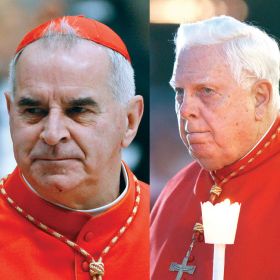Quick Action the Best Route
By Fr. Raymond J. de Souza
Last week Cardinal Keith O’Brien, who resigned as archbishop of Edinburgh just before the recent conclave upon revelations of “lewd behaviour” and “drunken fumblings,” spoke for the first time since press reports led him to absent himself from the conclave. The accusations were made by Scottish priests who reported O’Brien had made advances after excessive drinking in years past. The accusations did not involve minors. “It’s been quite a difficult time for me, quite a humbling experience for me,” Cardinal O’Brien said. “It’s very difficult for them too. That is why I have apologized for being a teacher who has not been able to live up to the teaching of the Church. We know what’s against God’s law. Consequently we should try to live by God’s law. I’ve apologized for my failures in that respect.” Also last week, Pope Francis went to the papal basilica of St. Mary Major to pray the rosary on the first Saturday of May. Just as on his visit to St. Mary Major on the morning after his election as Pope, Francis was greeted by the cardinal archpriest of the basilica, who is now Cardinal Santos Abril y Castello. It used to be Cardinal Bernard Law, former archbishop of Boston. Therein lies a tale of what to do when bishops behave badly, a tale highlighted by the drama of the recent conclave. Cardinal Law’s case is well known. While never accused of any personal acts of sexual immorality or abuse, in 2002 the sexual abuse scandal that broke in Boston exposed critical errors in his management of the archdiocese. He resigned in December 2002, co-operated fully with the criminal investigations underway in Massachusetts, and then was appointed in 2004 as archpriest of St. Mary Major, an honorary post usually given to a retired cardinal. That appointment caused no little controversy. Mounting frustration with the ongoing attention to Cardinal Law led the Holy See to remove him from St. Mary Major just days after his 80th birthday in November 2011. So swift was his forced retirement that it took Cardinal Law himself, as well as his successor, by surprise. In the case of Cardinal O’Brien, reports of his behaviour from years past were brought to the attention of the papal nuncio late last fall, who investigated. Convinced that there was something to the claims, the reports were forwarded to the Holy See. Cardinal O’Brien conceded the general truth of the allegations and it was decided that he could no longer continue as archbishop of Edinburgh. However, given that Cardinal O’Brien would turn 75 on March 17 (his middle name is Patrick), 2013, it was decided that he would step down on his 75th birthday, the usual retirement age for bishops. Cardinals usually stay some time past that date, so a resignation accepted on the birthday itself would have sent a signal to careful observers. The Holy See sought to find a way to ease O’Brien out while sparing the Scottish faithful the trauma of a resignation in disgrace. Then came the earthquake of Feb. 11, with Benedict XVI’s renunciation of his office, and the election of Francis on March 13, with his subsequent visit to St. Mary Major the next morning. No one could have predicted the events of Feb. 11 and March 13, but the decisions taken in the Law and O’Brien cases took on greater significance in light of them. Had Cardinal O’Brien been asked to step down in December or January, then subsequent events would have unfolded differently. With no conclave on the horizon, the press reports of late February about the allegation of sexual sin would not have been accelerated, prompting an abrupt resignation and casting a shadow over conclave preparations. By allowing him to stay on, the Holy See unwittingly made a bad situation worse, even if no one could have reasonably expected a conclave to occur so soon. In Cardinal Law’s case the opposite took place. No one could have expected that, within 12 hours of his appearance on the central loggia of St. Peter’s, the new Pope would be at St. Mary Major, entrusting his pontificate to the Blessed Mother. But he was, and if Cardinal Law had been at his side as archpriest of St. Mary Major, the international story would not have been the new Pope piously visiting the Mother of God, but the presence of the disgraced Cardinal Law at his side. It would have been entirely unremarkable if Cardinal Law had been permitted to stay on after his 80th birthday — his predecessor held the job until he was 82. When Cardinal Law was removed immediately upon turning 80, instead of allowing a more graceful retirement at some future date, the Holy See spared itself a major embarrassment on the morning of March 14, which would have marred Pope Francis’ first full day as Pope. In both cases, what the future would hold was not known. But quick action, rather than tarrying, in the discipline of bishops, served the Church better.
|
.
Any original material on these pages is copyright © BishopAccountability.org 2004. Reproduce freely with attribution.
